Investigation and Design of a Picket Fence Thickener for the Waste Water Treatment Industry
Glossary
DBO Design Build Operate
PFT Picket Fence Thickener
WWT Waste Water Treatment
WHO World Health Organisation
Contents
3.2 History of Water Treatment
3.3 Benefits of Water Treatment
3.5 Overview of Modern Waste Water Treatment Plant
3.5.3 Picket Fence Thickeners (PFT)
3.5.4 Thickened Sludge Holding Tank
3.6 Procedure to Design Picket Fence Thickener
3.6.1 Introduction to Procedure
3.6.2 Picket Fence Thickener Mechanical Components
3.6.3 Picket Fence Thickener Design Procedures
3.6.4 Procedure to Model Picket Fence Thickener
Figure 1 Typhoid Mortality Rates
Figure 2 Wastewater Treatment Processes
Figure 3 Circular Basin Thickener Layering
Figure 4 Picket Fence Thickener Mechanical Components
Figure 5 Settling Velocity Graph
Figure 6 Underflow Concentration Graph
Figure 7 Cosme Italia PFT Mechanism
Figure 8 JK Fabrication PFT Mechanism
Equation 1 Mass Balance Equation
Equation 2 Area required for Thickening
Equation 3 Area required for Clarification
About the Company
Glan Agua Ltd is a private limited company specialising in water and wastewater engineering based in Loughrea Co. Galway. Glan Agua was established in 2008, and has since grown in size considerably. Glan Agua specialises in the Design Building and Operating (DBO) of water and wastewater plants in Ireland, and more recently in the United Kingdom. Glan Aguas client base includes Local Authorities, and Private Clients in the Pharmaceutical and Food Sectors.
Glan Agua is now part of the global Moto-Engil group. This Portuguese group, with an annual turnover of over €2 billion in 2013, provides Glan Agua with significant financial support and engineering expertise. (Agua 2017)
Project Basis
This project will be based on the Picket Fence Thickener (PFT) design of the upgrade to the Inniscarra Sludge Treatment Plant in Co. Cork.
The Inniscarra Water Treatment plant currently provides potable water to a large portion of Cork City and Cork County, including areas to the west and south of the city as well as Cork Harbour and Ringaskiddy.
The Inniscarra Sludge Treatment Plant is tasked with the treatment of the following waste streams from the main water treatment works: Backwash water from cleansing of gravity filters, Bleed Sludge from Lamella Clarification Tanks, Decant Water from Picket Fence Thickeners, Filtrate from Sludge Press Dewatering, and to treat the Scour and Surface Water Flows.(2017a)
Objectives
The goal of this project is to Investigate and design a Picket Fence Thickener mechanism. The design of this mechanism will use Best Engineering practise in selecting the appropriate PFT mechanism designs. Designs from three competing companies will be developed and compared to try and develop a hybrid design which features the best elements of each design.
Once the design is finalised, the next step is to analysis the design in the Finite Element Analysis software Ansys. This software will help to identify any possible weak points in the Mechanisms structure, and to help verify any new design elements and features which may be developed to counteract the weak points in the design.
To get a better understanding of one of the needs of Water Treatment in modern society, we have to look at a major cause of disease and infections, which may be prevalent in the water cycle.
Human disease or infections because of interaction with animal origins are a major contributor to a variety of infections. Microbes from animal sources have, during the course of human history, evolved into more serious and eventually deadly diseases. Examples of these include smallpox, flu, malaria, tuberculosis, plague, measles and cholera, all of which evolved from diseases originating from animals.
Although farm animals can be a major cause of infections, children and adults can also pick up infectious diseases from our domesticated pets. Usually they remain nothing more than a nuisance but can, in extreme circumstances result in something more serious and threatening.
The fact that animal sources and especially animal microbes can cause such damage to the human populace is a major reason behind the vital role effective Water Treatment has in protecting a developed society from epidemics and influenza. Although not the only element that can infiltrate the water cycle, it is an element that effective, modern and purposed Water treatment and Waste Water treatment can protect the population from, and deliver a safe and secure water source.
Water Treatment is the process of converting raw, untreated water into water suitable for Industrial, Domestic, or Irrigation purposes. Water Treatment removes contaminants and undesirable components from the raw water by a variety of different processes, so the water becomes fit for its desired end use. There are 3 stages to the water treatment process. Primary Secondary and Tertiary.
The new sludge treatment facility in Inniscarra includes Backwash Settlement Tanks, Blended Sludge Tanks, Picket Fence Thickener Units, Thickened Sludge Storage Tanks, and Membrane Filter Plate Presses.(Kennelly 2017b)
Water Treatment has been an area of great importance through modern human history. The ability of a society to provide safe and sustainable water to its populace can result in lower mortality rates and ultimately a more successful and thriving economy.
In ancient Greek and Sanskrit (India) writings dating back to 2000 BC, water treatment methods were recommended. People back than knew that heating water might purify it, and they were also educated in sand and gravel filtration, boiling, and straining. (Treatment 2018)
These advances were followed by the Egyptians post 1500 BC who first discovered the principle of Coagulation, a process involving the addition of chemical alum to the water to increase particle settlement. (3.4 Water Treatment Processes). This process is still a major element of most water treatment plants including that of the aforementioned Inniscarra Water treatment plant.
Advances in water treatment continued throughout history as, in 500 BC, Hippocrates used the first bag filter to trap sediments that caused bad tastes and odours.
During the Middle Ages (500-1500 AD), advances in water transportation by the Romans were no longer applied and many important infrastructure elements such as Aquaducts were either destroyed or not used.
After this, experimentation continued with sand filtration (1676- Francis Bacon), and eventually the first domestic water filters in the 1700’s, manufactured from wool, sponge and charcoal.
Eventually, the first Municipal water treatment was built in Scotland in 1804, based on a simple slow sand filtration, and some years later the addition of the first water pipes were installed. In 1854, a chlorine epidemic, which seemed less severe in areas which used sand filtration systems, prompted the discovery that contamination by sewage water was a direct cause of the outbreak, so chlorine was added to the water to help purify it. This first case of water disinfection eventually led to governments starting to install municipal sand filters and chlorination to the public water schemes.
Come the 1890’s, America led the way in developing rapid sand filtration to protect the public’s health. The Filter capacity was also improved by cleaning the filter with a powerful jet stream. Also discovered was the fact that rapid sand filtration techniques were improved when preceded by coagulation and other sedimentation techniques. Also, as chlorination became more prevalent in the water treatment industry, waterborne diseases such as typhoid and cholera became less common.
(https://1phil4everyill.wordpress.com/tag/typhoid-fever/)
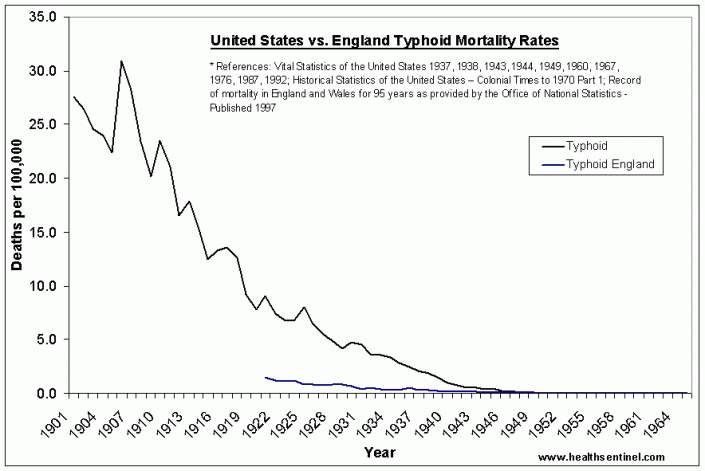
Figure 1 Typhoid Mortality Rates
The graph above (Figure 1) shows the drastic fall of Typhoid Mortality Rates from a high of 30 deaths per 100,000 people to the near abolition of typhoid by the 1950’s. This reduction is due to improved water chlorination and to vaccination procedures, introduced in the United States.(Treatment 2018)
The benefits of modern and effective water treatment in society are widely proven. According to the World Health Organisation (WHO), (Prüss-Üstün et al. 2008), annually safe water could prevent the deaths of over 2.76 million people, by cases including diarrhoea, malaria, and malnutrition.
Nationally, as lately as 2007, an outbreak of Cryptosporidium, which occurred in the outskirts of Galway city, resulted in 120,000 people being forced to boil their water, or buy bottled water for 5 months due to the outbreak. Cryptosporidium, a parasite that lives in the intestine tract of infected humans and animals, is shed through faeces, and contaminates the areas soil and water cycle.
During this outbreak, from March 2007 to the following August, a total of 242 cases were notified while another 497 non-reported cases occurred. There was both a financial and health cost to this outbreak. A total of 40 people had to be hospitalised due to the outbreak. This outbreak, which came during the tourist season in Galway, resulted in 1 in 8 hotel and guesthouse bookings to be cancelled, at a total of cost of €8m to the hospitality sector and a further €3.5m cost bore by the purchase of bottled water.
It was later revealed in the long ranging report(Chyzheuskaya et al. 2017) that, an adequate treatment process, costing just €1.6m would have resulted in an €11 saving for every €1 invested.
There are many different processes used by Water Treatment Companies such as Glan Agua and Local Authorities to remove impurities and contaminants from the chosen water source. These processes are used individually and in sequence to convert raw untreated water into consumable water for the domestic or Industrial consumer. Some of these processes include Sedimentation, Flocculation, Filtration, Chlorination, Fluoridation and pH adjustment.
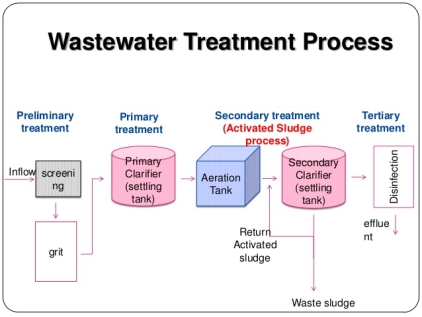 The water treatment process can be divided into 3 distinct stages, Primary, Secondary and Tertiary treatment.
The water treatment process can be divided into 3 distinct stages, Primary, Secondary and Tertiary treatment.
Primary water treatment involves basic processes to remove suspended solid waste and reduce its biochemical oxygen demand (BOD), the amount of oxygen microorganisms that must be consumed to breakdown the organic material present in the wastewater. This, in turn, increases dissolved oxygen, which is good for aquatic organisms and food webs. Primary treatment can reduce BOD by 20 to 30 percent and suspended solids by up to 60 percent.(Omar Malik 2013)
Secondary treatment uses biological processes to catch the dissolved organic matter missed in primary treatment. Microbes consume the organic matter as food, converting it to carbon dioxide, water, and energy. While secondary treatment technologies vary, from the activated sludge process.
Tertiary treatment. Tertiary treatment is the final cleaning process that improves wastewater quality before its reused, recycled or discharged to the environment, like a river source. The treatment removes remaining inorganic compounds, and substances, such as the nitrogen and phosphorus.
Within these treatments, there are a number of vital processes that are used to help separate the unwanted particles from the main water source. These processes include Sedimentation and Flocculation.
Sedimentation is the process of allowing particles denser than the water to settle out of suspension under the effect of gravity. The suspended solids may exist as silt or bacteria in their natural state. These elements may have been modified by pre-treatment such as coagulation to form flocs. (Brooks 2015) The particles that settle out from the suspension become sediment and is known as sludge. In the Inniscarra Water Treatment plant, this is completed by using gravity filters.
Flocculation, also known as Coagulation is a chemical water treatment process. This is typically applied prior to rapid sand filtration processes such as Sedimentation, to enhance the filtration process. Flocculation involves the addition of a chemical such as alum which produces positive charges on the particles to overcome the repulsive charge and destabilize the suspension. The Flocculating agents promote flocculation by causing colloids and other suspended particles in the liquid to aggregate, or join to form a floc.
Flocculants gather the destabilized particles together and cause them to agglomerate and drop out of solution.
A modern Waste Water Treatment plant, such as the plant being constructed and operated by Glan Agua, uses many state of the art processes and procedures to reduce the impact of the sludge by product on the environment.
The Inniscarra Sludge Treatment plant will be required to treat the following waste streams from the main water treatment works:
Backwash Water from cleaning of Gravity Filters
Bleed Sludge from the Lamella Clarification Tanks
Decant Water from the Picket Fence Thickener Tanks
Filtrate from Sludge Press Dewatering
Scour and Surface Water Flows
To cater for these treatments, the plant will therefore consist of the following process units:
| Quantity | Process Unit |
| 2 | Washwater Settlement Tanks |
| 1 | Blended Sludge Tank |
| 2 | Picket Fence Thickener Units |
| 1 | Thickened Sludge Holding Tank |
| 3 | Filter Plate Presses |
Backwash water is generated at the Main Water Treatment works during the rapid gravity filter cleansing process, or backwashing. This water will, typically have elevated solids content and will therefore require further treatment prior to being recycled. This treatment involves removing solid particles by settlement through gravity in the Backwash Settlement Tanks.
The solids in the washwater will tend to settle out of suspension over the course of 2 to 4 hours depending on plant loadings and mode operations.
Once the settlement cycle is complete, a pneumatically actuated valve will be opened and clarified water will be de-canted from the top levels of the tank and discharged to the chosen River Output. (River Lee) Sludge, which has settled onto the base of the Backwash Tank, will be transferred using Settled Sludge Pumps and sent forward for Further Treatment.
The purpose of the Sludge Blending Tank is to blend and homogenise process streams from:
Wash water Tanks Settled Sludge
Existing Clarifier Bleed Sludge
Filter Plate Press Waste from Cloth Wash Water.
The Blending of the Sludge Streams is completed by means of a Submersible Mixer. This Mechanical Mixing will operate on a Time/Interval Basis to ensure the sludge is properly mixed prior to Thickening. The Blended Sludge will be continuously Pumped forward to the Picket Fence Thickener for Thickening, on a Duty/Assist/Standby arrangement. In the event of these Pumps failing, there is a high level overflow outlet which will discharge any blended sludge to the PFT in the case of Pump Failure.
Picket fence thickeners enable the thickening and settlement of particles suspended in water into a sludge, which can then be removed for disposal or treatment. Their rotating blade consists of a series of vertical rods with horizontal supports, so look similar to a garden fence. This is turned by a motor about a vertical axis positioned centrally in the process tank as waste water slowly enters the tank.(Fabtech 2016)
Picket Fence Thickeners are large circular tanks that are used to thicken primary sludge before digestion. A PFT works by slowly rotating its mechanism in the tank at speeds a slow as 0.12 RPM. By rotating slowly, the frame design of the PFT creates vertical passage ways in the sludge. These passageways permit the movement to the surface of separated water and micro bubbles, which are released from the floccs. In addition, as the PFT rotates, it breaks up the Scum Mat, which may have formed on the base of the tank, as this mat is broken up; it begins to release entrapped gasses.
As primary sludge enters the tank the heavier sludge gravitates to the base of the tank, this creates a sludge blanket. As the sludge blankets thickness increases, it squeezes water out of the sludge which increases its dry solids percentage from 1.5% to roughly 3%. The lighter sludge squeezed out of the blanket is then drawn off as supernatant and used in Secondary Process. The compressed sludge is also drawn off from the bottom, tapered central hopper, at the base of the tank.
The Thickened Sludge Holding Tank is designed to reduce the effect of the Thickness of the sludge received from the PFT tank. This tank holds the sludge until the Filter Press Plate is ready to receive more sludge in its next cycle.
This glass lined steel tank has a vertical geared paddle to gentle agitate the sludge, ensuring the sludge is homogenised prior to being pumped to the Filter Press Plate, while also preventing the break-up of flocc formed through the PFT.
The mechanical method used in this Waste Water Treatment plant to Dewater the sludge is the Filter Press Plate.
Sludge is preconditioned with polyelectrolyte prior to dewatering in the filter press. Progressive Cavity pumps transfer the sludge to the Filter Plate Presses. Once inside the Presses, compressed air is used to inflate the membranes and generate a squeeze pressure of 11 bar.
Once theses dewatered sludge cakes are released into the bays below, they are removed for further treatment externally.
The most common thickener is the Circular Basin Type Thickener. The Flocculant-treated feed slurry enters through the central feed well or central diffuser drum, which disperses the feed gently into the thickener. The feed suspension falls until it reaches a height where its density matches the density of the surrounding suspension and it spreads at that level. Solids concentration increases in the downward direction and this gives stability to the thickening process. The overflow is collected in a trough around the circumference of the basin. Raking mechanisms, rotating slowly around the centre column, promote consolidation in the compression zone and aid solids discharge through the tapered bottom central hopper opening.
In industry applications such as the Waste Water treatment sector, the height of the tank does not differ largely between plants, while the basin area of the tank fluctuates to handle the slurry loadings.
Circular Basin Type, Picket Fence Thickeners all exhibit very similar components and features. These features, regardless of tank area requirements, allow the tank to thicken the incoming sludge, and collect overflow from the tank.
The most important design dimensions of a Picket Fence Thickener are the Pool Area and Depth of the Tank. The pool area is, chosen as the largest of the three layer requirements. In an operational thickener, there are three distinct layers, a Clarification, Zone Settling and Compression Layer.

Due to the addition of flocculation agents in the slurry, the feed is often in the Zone Settling region by the time it enters the clarifier. In practise, the Clarification layer is used as a buffer and safety factor for large feed influxes and abnormal fluctuations in the interface level. [Solid Liquid Separation]
In Waste Water Treatment Facilities, all PFT Tanks exhibit very similar if not identical mechanical features and components. Tank construction can vary from precast concrete, circular steel tanks, to glass lined concrete tanks depending on budget and requirements for the plant.
1) At the centre of each Picket Fence Thickener is a Motor or Drive used to rotate the mechanism through the sludge. These motors are usually accessible for maintenance by means of a walkway or bridge spanning the diameter of the tank. This motor will be designed to deal with high torque loads at speeds as low as 0.12 Revolution Per Minute.
2) This Central shaft is used to transmit the rotational power from the drive to the scraper mechanism at the base of the tank.
3) The Surface Scraper is used to motion the sludge around the central shaft. The scrapers, positioned at an angled offset to the lateral axis encourage the settled sludge down the sloped base, into the central hopper of the PFT Tank.
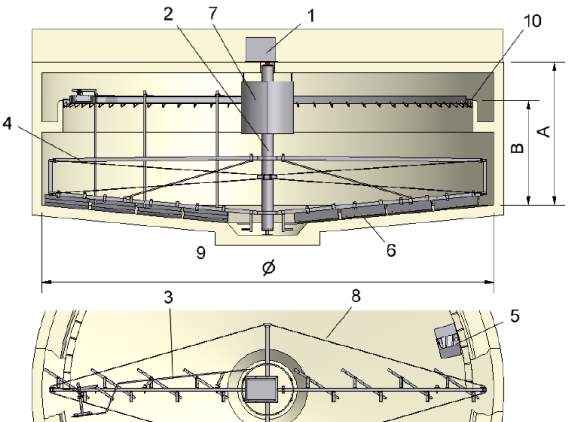
Figure 4 Picket Fence Thickener Mechanical Components
4) Lateral Arms add strength and stability to the PFT mechanism, while also helping to break up the sludge blanket, and further aid flocculation.
5) Scum-Box, this box is used to collect the supernatant discharge from the overflow, before being pumped off for discharge or further treatment. This scum lies on the top layer of the clarified water and is
6) Bottom Scrapers, with hard plastic bases are used to move settled sludge around the base of the tank. The Plastic lip is used to reduce wear on the base of the tank, and to move sludge off the base of the tank more easily.
7) Central Diffuser Drum is used to evenly spread the incoming sludge across the top face of the PFT Tank. This drum rotates with the central shaft and openings along the outer case allowing the sludge to be spread evenly into the PFT Tank.
8) Tie Rods are once again a structural strength element used to tie the lateral arms into the central shaft, reducing shearing stress within the lateral arms.
9) The Central Hopper is used to collect the thickened sludge before being pumped onwards for further dewatering. The hopper is sloped to reduce the risk of a blockage.
10) Supernatant will flow to the top of the PFT tank and overflow a Circumferential Collection Launder. This launder will feature V-Shaped weirs to allow for fine tuning on the loadings of each tank.
In practical use, there are a number of ways to calculate the basin requirements of the PFT Tank:
Design based on experience is based around Solid Flux. Solid flux is the Settling velocity multiplied by the Solids Concentration. The area of the thickener is then found by dividing the Anticipated Solids Feed by the flux.

This process is based largely on experience, and calculations to discover the Settling Velocity can be very complicated and time consuming.
Design based on experience is invaluable in a company as an experienced engineer will know instinctively what parameters to design the Picket Fence Thickener to, once given the inlet flow loadings and Dry Solids Content of the incoming sludge.
Design based on Laboratory Data is the most ideal technique if the Homogenised Sludge used pumped into the PFT Tank is available. There are two distinct techniques to use with the Laboratory Data, the Talmage and Fitch method, or the Solids Flux approach, for the purpose The most common thickener is the Circular Basin Type Thickener. The Flocculant-treated feed slurry enters through the central feed well or central diffuser drum, which disperses the feed gently into the thickener. The feed suspension falls until it reaches a height where its density matches the density of the surrounding suspension and it spreads at that level. Solids concentration increases in the downward direction and this gives stability to the thickening process. The overflow is collected in a trough around the circumference of the basin. Raking mechanisms, rotating slowly around the centre column, promote consolidation in the compression zone and aid solids discharge through the tapered bottom central hopper opening.
In industry applications such as the Waste Water treatment sector, the height of the tank does not differ largely between plants, while the basin area of the tank fluctuates to handle the slurry loadings.
Circular Basin Type, Picket Fence Thickeners all exhibit very similar components and features. These features, regardless of tank area requirements, allow the tank to thicken the incoming sludge, and collect overflow from the tank.
The most important design dimensions of a Picket Fence Thickener are the Pool Area and Depth of the Tank. The pool area is, chosen as the largest of the three layer requirements. In an operational thickener, there are three distinct layers, a Clarification, Zone Settling and Compression Layer.
Due to the addition of flocculation agents in the slurry, the feed is often in the Zone Settling region by the time it enters the clarifier. In practise, the Clarification layer is used as a buffer and safety factor for large feed influxes and abnormal fluctuations in the interface level. [Solid Liquid Separation]
In Waste Water Treatment Facilities, all PFT Tanks exhibit very similar if not identical mechanical features and components. Tank construction can vary from precast concrete, circular steel tanks, to glass lined concrete tanks depending on budget and requirements for the plant.
1) At the centre of each Picket Fence Thickener is a Motor or Drive used to rotate the mechanism through the sludge. These motors are usually accessible for maintenance by means of a walkway or bridge spanning the diameter of the tank. This motor will be designed to deal with high torque loads at speeds as low as 0.12 Revolution Per Minute.
2) This Central shaft is used to transmit the rotational power from the drive to the scraper mechanism at the base of the tank.
3) The Surface Scraper is used to motion the sludge around the central shaft. The scrapers, positioned at an angled offset to the lateral axis encourage the settled sludge down the sloped base, into the central hopper of the PFT Tank.
4) Lateral Arms add strength and stability to the PFT mechanism, while also helping to break up the sludge blanket, and further aid flocculation.
5) Scum-Box, this box is used to collect the supernatant discharge from the overflow, before being pumped off for discharge or further treatment.
6) Bottom Scrapers, with hard plastic bases are used to move settled sludge around the base of the tank. The Plastic lip is used to reduce wear on the base of the tank, and to move sludge off the base of the tank more easily.
7) Central Diffuser Drum is used to evenly spread the incoming sludge across the top face of the PFT Tank. This drum rotates with the central shaft and openings along the outer case allowing the sludge to be spread evenly into the PFT Tank.
8) Tie Rods are once again a structural strength element used to tie the lateral arms into the central shaft, reducing shearing stress within the lateral arms.
9) The Central Hopper is used to collect the thickened sludge before being pumped onwards for further dewatering. The hopper is sloped to reduce the risk of a blockage.
10) Supernatant will flow to the top of the PFT tank and overflow a Circumferential Collection Launder. This launder will feature V-Shaped weirs to allow for fine tuning on the loadings of each tank.
In practical use, there are a number of ways to calculate the basin requirements of the PFT Tank:
Design based on experience is based around Solid Flux. Solid flux is the Settling velocity multiplied by the Solids Concentration. The area of the thickener is then found by dividing the Anticipated Solids Feed by the flux.

This process is based largely on experience, and calculations to discover the Settling Velocity can be very complicated and time consuming.
Design based on experience is invaluable in a company as an experienced engineer will know instinctively what parameters to design the Picket Fence Thickener to, once given the inlet flow loadings and Dry Solids Content of the incoming sludge.
Design based on Laboratory Data is the most ideal technique if the Homogenised Sludge used pumped into the PFT Tank is available. There are two distinct techniques to use with the Laboratory Data, the Talmage and Fitch method, or the Solids Flux approach, for the purpose
of this Project I will cover the Talmage and Fitch Method as shown below:
If this is available, this Sludge is let to settle in a 1000 mL Graduated cylinder. In seconds an interface separating the solids and the clear water on top is formed with a certain settling velocity, measured with respect to time. Interface height is plotted against time and the Zone Settling Velocity is calculated from the initial slope of the graph.
The Settling Velocity of the sludge, will depend on the concentration of solids within the Sludge. Right after the sludge enters the cylinder, there are 2 interfaces moving towards each other. One from the bottom up due to the building up of layers of sludge from the bottom. The second interface is moving down from top to bottom, this is the blanket of settling sludge, which is moving as the settling velocity. These 2 layers will then meet and settling will slow down. Once the settling ceases the compaction of the blankets will begin. Ch3
This different settling zones can be identified in the below graph.
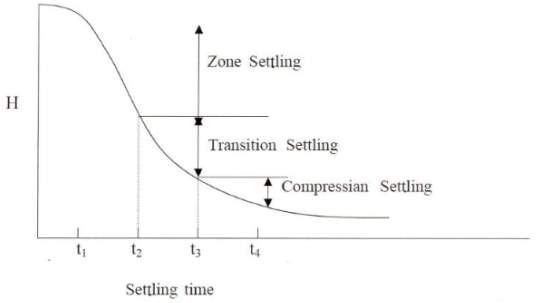
Figure 5 Settling Velocity Graph
To calculate the PFT Tank requirements using the Talmage and Fitch procedure the following steps are applied to this graph:
The slope of the Zone Settling region is determined; this corresponds to the Zone Settling Velocity for the clarification layer.
Extend the tangents from the ZSV region and Compression region and bisect the angle formed to locate point 1. Now draw a tangent to the curve where point 1 intersects the curve. (Figure 6 Underflow Concentration Graph)
We now calculate the Underflow Interface Height (Hu) by placing the known values Co, Ho and Cu into a Mass Balance Equation.
Where
Co = Initial Dry Solids Concentration
Ho = Initial Interface Height
Cu = Underflow Dry Solids Concentration
Once these values are reinstated we get the below equation.

Once Hu is calculated plot the value on the graph and draw a horizontal line until it intersects with the tangent, and this thus determines the value of tu. This value indicates the time taken to reach an underflow concentration in the thickener. This can be seen in the below graph.
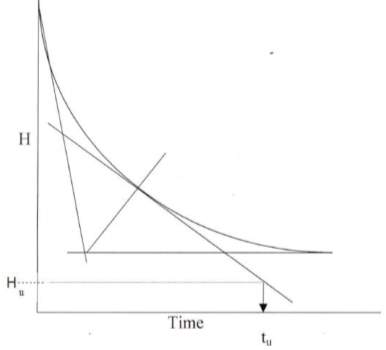
 The area required for thickening can then be calculated by the following equation:
The area required for thickening can then be calculated by the following equation:
Where
Q = flowrate to the aeration tank excluding the recycle flow
R = Recycled Sludge Flow
Q + R = Total Flow to the clarifier
Tu = Time required to reach underflow concentration
Ho = Initial Interface Height at T = 0
1.5 = Desired Scale Up factor
The area required for clarification must then be calculated using the following equation:

Where
Q = Effluent flow over the weir
2.0 = Scale Up Factor
The final step is to see which layer; the Clarification or Thickening layer have the largest area requirement. The largest area will be the desired area for the Picket Fence Thickener
Design Based on Calculations:
This procedure to design the Picket Fence Thickener based on Calculations requires a detailed understanding of Fluid Dynamics, encompassing the Navier Stokes Equations and detailed analytical equations. Design based on Calculations can be encompassed into Design based on Experiment where the calculated Zone Settling Velocity is calculated and used in the Clarifier Area requirements. This is only required when the clarity of the overflow is critical however, and the Clarification layer is usually used as a Safety Factor and Buffer.
When completing these calculations, the following assumptions are made:
Flow is Linear Stream Velocity (m/s)
All floc particles are spherical in shape, with Diameters ranging between 1 and 2.5 mm
Design based on calculations is not practical for a real life environment as, among other factors, the loadings on the PFT change due to weather conditions, sludge quality and Backwash Cycle durations.
Design Based on Industry Standards
Picket Fence Thickeners based on this design rely on several very important factors. These factors include accurate Process Flow Diagrams for the plant, plant components, an experienced operator and availability of Tank sizes from Tank Manufacturers.
This process, obtained from Glan Agua, is the most common Industry used process as it delivers sizing of the PFT Tank in a very short time period while also encompassing Dry Solids percentage and Backwash Durations. Many of the figures are, adopted from previously designed process maps for the Inniscarra Plant.
The procedure, as follows has the following assumptions:
Procedure based on Inniscarra Waste Water Treatment plant.
Procedure based on a standard Coagulation, Flocculation, Clarification plant with Rapid Gravity Sand Filtration.
Density of Sludge = Assumed same as water (1000mg/L)
First, the Backwash Water Volumetric Loadings are calculated:
Area of Filtration Tank = X m2
Maximum Backwash Rate = Y m/hr
Backwash Duration = Z hours
Backwash Water Generated = 3776.14 (m3 /day)
Next Solids Loadings are calculated:
Estimated Percentage Dry Solids of Wash Water = 0.025% (250 mg/L)
Density of Sludge = 1000 mg/L
Kilograms of Solids in Washwater per day = (XYZ)(1000)(0.025%) = 944.035 kg/day
Now the Clarifier Sludge loadings are calculated:
For a traditional up flow clarifier, assume a percentage of the total plant flow – here a 1.5% is assumed
Assume a % DS (dry solids) content within this of 0.5 %
Backwash Tank Sizing:
To size the backwash tank, the daily volume of backwash water is used, plus a factor of safety of around 10 to 15%. The next step is to use the most conveniently sized tank to cater for this volume. This volume depends also on the standard tank sizes available, aswell as the hydraulics and topography of the site itself.
Of the incoming volume, assume it will settle to 1.5%, so for example:
Take the kg of Solids in Washwater per day as calculated above (Let = A kg/day)
Density = 1000 kg/m3
Volume of settled sludge = (A)/(1.5% * 1000) = B
Picket Fence Thickener Sizing:
The Industry Standard Maximum Upward Flow Velocity (according to Water Research Council (WRC) = 1.5 m/hour
Maximum Upward Solids Loading (according to WRC) = 4 kg/m2.hour
Volume of settled backwash sludge = B
Volume of Clarifier Sludge = C (as calculated above)
Total Volume of Incoming Sludge = B+C
Resulting combined solids content can be calculated by continuity mass balance. Once you have this percentage, you can calculate kg of combined sludge solids as per above (use density of 1000 kg/m3)
Minimum diameter for PFT according to upward flow velocity = (B+C)/1.5 m/hr. In the case of this PFT, the diameter has been based on solids loading.
The minimum diameter for the PFT according to solids loading = incoming solids flow rate (kg/hr)/4 kg/m2.hour. Solids enter the PFT from two sources, the Backwash Tanks, and from the Sludge Bleed Tank. The sum of these streams is the total solids loading for the PFT. This results in a total solids loading for the PFT = 118.75 kg/hour.
To calculate the minimum diameter: (118.75 kg/hour) / (4 kg/m2.hour), which results in a 6.14m Diameter.
The next step is to apply a factor of safety and Tank size constraints to this value. A factor of Safety of 1.5 is applied, which results in a 9.22m Diameter Tank. As with all Real Life situations, there are certain constraints with regards to the Tank Diameter, these include Manufactured Tank sizes available, cost, and site layout among other elements. As a result, the factor of safety, for this site has been reduced slightly to 1.42, which results in a tank diameter of 8.73m.
Generally, a minimum of 3.5 – 4.0 m is allowed for a sludge height. Of this at least 1.5 m sludge blanket, 0.5 m freeboard, and allowance for the distribution drum are allowed.
Computational Fluid Dynamics (or CFD) is the sue of applied mathematics, physics and computational software to visualize how a fluid, such as a gas or liquid flows, as well as how the fluid affects the objects it flows past. Computational fluid dynamics is based on the Navier-Stokes equations. These equations describe how the variables such as velocity, pressure, temperature and density of a moving fluid are related.
(http://whatis.techtarget.com/definition/computational-fluid-dynamics-CFD)
While defined by boundary conditions, such as the physical layout of the part being studied, improving computational power, brought on by advancements in computing technology, have allowed for improved accuracies and speed of complex simulation scenarios, such as transonic or turbulent flows.
(https://en.wikipedia.org/wiki/Computational_fluid_dynamics)
Sice the 1970’s, the increasing computational power has been accompanied by a rapid development in the software intended for solution of fluid flow problems. Currently there is a wide range of software suites, such as Ansys, intended for the solution of complex fluid flow problems. To begin with, CFD was almost exclusively associated with the aerospace and mechanical industries allowing simulation of the process occurring in the combustion chambers of rocket engines and physio-chemical processes in the flow around the aircraft airframe.
Subsequently CFD found applications with chemical engineers, mainly for design of reaction vessels, and in the last two decades, application of CFD has been extended to the civil and environmental engineering sectors (Kochevsky, 2004).
Recent developments in multiphase flow research have seen a steady growth in the application of CFD modelling in wastewater treatment, with a focus on the design of pumping stations, headworks, screens, grit chambers, flowsplitters, AS tanks, clarifiers and digesters. (Anna M. Karpinska 2015)
In this section of the report, the design phase of the project is discussed. The Picket Fence Thickener Mechanism requirements are identified. Using knowledge obtained during the literature review, and knowledge obtained from previous PFT mechanism designs, initial concept designs are developed which attempt fulfil the design requirements and solve any prevalent issues regarding the Mechanisms technical ability and function.
During the initial design concepts phase, the Picket Fence Thickener mechanism design selection will be based on Best Engineering Practise by focusing on market available designs from different manufacturers. The chosen manufacturers are:
Cosme Italia
JK Fabrication
Techno Converting
Cosme Italia, an Italian firm use a very simple design with a minimal number of pickets and large tie rods which are used to tie the structure together to improve its structural strength. These tie rods are attached along the horizontal axis and tie the ends of the mixing mechanism into a tension setup with two supports along the central axis of the mixer.
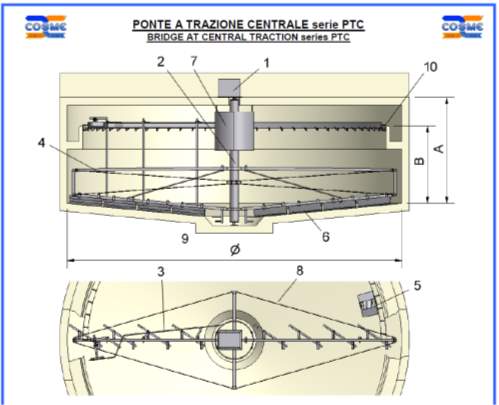
This design features many distinguishable features:
6 Vertical Passageway shafts (3 on each side)
8 Angled, Bottom Scrappers (4 on each side)
4 Tensioned Tie Rod supports
Thompson profile on outer circumference overflow weir
JK Fabrication, an engineering company based in Northern Ireland, manufacture, supply and install a much more comprehensive PFT Mechanism for the Waste Water Treatment Industry.
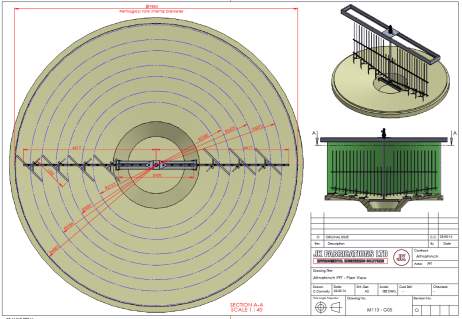
This mechanism employs the same basic features of the Cosme product but employs 24 Vertical Passageway shafts (12 on each side). This design allows more passageways of air to be created in the sludge, which therefore increases the amount of air that escapes the substance. This increased aeration of the sludge promotes more thickening and sludge particle settlement in the tank.
The increased number of passageways however, results in increased Manufacturing time, and thus increased cost for the customer.
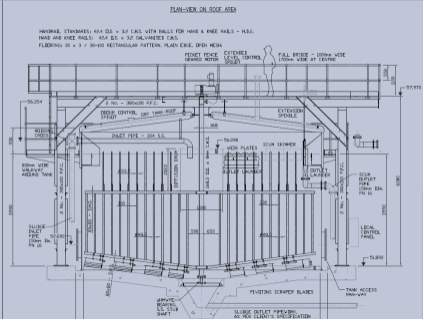
The work done to date for this project predominantly includes the extensive Literature Review, and research on several topics and subjects including Waste Water Treatment processes, Chemical processes, Modern Wastewater Treatment plant techniques and processes, with particular focus placed on the process completed by the Picket Fence Thickener Tanks. Work has been completed with regards to multiple procedures used to Calculate the basin area of the PFT based on several factors including Solid Loadings and Volumetric loadings for the Tanks. The tank height was also discussed concerning Freeboard allowance, Layer allowance, aswell as distribution drum allowance.
These methods incorporated Industry standard procedures, Industry assumptions and Factors of Safety including Solids Loading and Basin Size, incorporated into the Tank design.
[4]: https://1phil4everyill.wordpress.com/tag/typhoid-fever/
[5]: https://www.ajfabtech.com/picket-fence-thickeners-suit-every-situation/
[6]: http://archive.epi.yale.edu/case-study/primary-vs-secondary-types-wastewater-treatment
[7]: http://whatis.techtarget.com/definition/computational-fluid-dynamics-CFD
[8]: https://en.wikipedia.org/wiki/Computational_fluid_dynamics
[9]: https://www.sydneywater.com.au/Education/Tours/virtualtour/html/tertiary-treatment.html
http://mimoza.marmara.edu.tr/~orhan.gokyay/enve425/ch3.pdf
(Treatment 2018)
CHYZHEUSKAYA, A., CORMICAN, M., SRIVINAS, R., O’DONOVAN, D., PRENDERGAST, M., O’DONOGHUE, C. & MORRIS, D., 2017. ‘Economic Assessment of Waterborne Outbreak of Cryptosporidiosis’. Emerging Infectious Diseases, 23 (10), pp. 1650-1656.
FABTECH, A.J., 2016. Picket fence thickeners to suit every situation [Online]. @ajfabtech. Available from: https://www.ajfabtech.com/picket-fence-thickeners-suit-every-situation/ [Viewed 29/09/2017].
KENNELLY, C., 2017. Inniscarra WSS Mechanical Design Submission.
OMAR MALIK, Y.F.E., 2013. ‘Primary vs Secondary Wastewater Treatment’.
PRÜSS-ÜSTÜN, A., BOS, R., GORE, F. & BARTRAM, J., 2008. Safer water, better health.
FABTECH, A.J., 2016. Picket fence thickeners to suit every situation [Online]. @ajfabtech. Available from: https://www.ajfabtech.com/picket-fence-thickeners-suit-every-situation/ [Viewed 29/09/2017].
OMAR MALIK, Y.F.E., 2013. ‘Primary vs Secondary Wastewater Treatment’.
PRÜSS-ÜSTÜN, A., BOS, R., GORE, F. & BARTRAM, J., 2008. Safer water, better health.
AGUA, G., 2017. About Glan Agua | Water & Wastewater Ireland [Online]. Available from: http://www.glanagua.ie/about-us.php [Viewed 09/10/2017].
PRÜSS-ÜSTÜN, A., BOS, R., GORE, F. & BARTRAM, J., 2008. Safer water, better health.
PRÜSS-ÜSTÜN, A., BOS, R., GORE, F. & BARTRAM, J., 2008. Safer water, better health.
FABTECH, A.J., 2016. Picket fence thickeners to suit every situation [Online]. @ajfabtech. Available from: https://www.ajfabtech.com/picket-fence-thickeners-suit-every-situation/ [Viewed 29/09/2017].
AGUA, G., 2017. About Glan Agua | Water & Wastewater Ireland [Online]. Available from: http://www.glanagua.ie/about-us.php [Viewed 09/10/2017].
BROOKS, V.A.V.A.B.G.C., 2015. ‘Understanding Water Treatment Processes’. Tech Directions, 75 (1), 09//, pp. 22-25.
CHYZHEUSKAYA, A., CORMICAN, M., SRIVINAS, R., O’DONOVAN, D., PRENDERGAST, M., O’DONOGHUE, C. & MORRIS, D., 2017. ‘Economic Assessment of Waterborne Outbreak of Cryptosporidiosis’. Emerging Infectious Diseases, 23 (10), pp. 1650-1656.
FABTECH, A.J., 2016. Picket fence thickeners to suit every situation [Online]. @ajfabtech. Available from: https://www.ajfabtech.com/picket-fence-thickeners-suit-every-situation/ [Viewed 29/09/2017].
KENNELLY, C., 2017a. Inniscarra WSS Mechanical Design Submission.
KENNELLY, C., 2017b. Inniscarra WSS Mechanical Design Submission.
OMAR MALIK, Y.F.E., 2013. ‘Primary vs Secondary Wastewater Treatment’.
PRÜSS-ÜSTÜN, A., BOS, R., GORE, F. & BARTRAM, J., 2008. Safer water, better health.
TREATMENT, H.O.W., 2018. History of water treatment [Online]. s. Available from: https://www.lenntech.com/history-water-treatment.htm#ixzz4ujKBJ6vP [Viewed 12/10/2017].
You have to be 100% sure of the quality of your product to give a money-back guarantee. This describes us perfectly. Make sure that this guarantee is totally transparent.
Read moreEach paper is composed from scratch, according to your instructions. It is then checked by our plagiarism-detection software. There is no gap where plagiarism could squeeze in.
Read moreThanks to our free revisions, there is no way for you to be unsatisfied. We will work on your paper until you are completely happy with the result.
Read moreYour email is safe, as we store it according to international data protection rules. Your bank details are secure, as we use only reliable payment systems.
Read moreBy sending us your money, you buy the service we provide. Check out our terms and conditions if you prefer business talks to be laid out in official language.
Read more